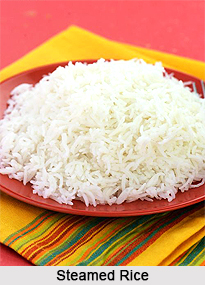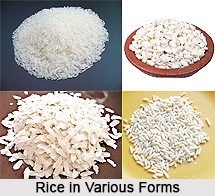 Rice in Bengali cuisine occupies a rather important place. Rice essentially is the chief diet of the Bengalis. When it is sold as par-boiled, it is semi prepared. In some cases it is sold as unpolished, still retaining the colour of the husk. It forms the basis of almost all meals in Bengal and takes many forms in its preparation. There is a great variety and quality of different types of rice found here. According to some agricultural experts, the terrain is varied enough to grow 10,000 indigenous varieties of rice. Apart from this great variety, the different ways of processing rice help to create a whole universe out of this one particular grain- puffed rice, rice flakes, popped rice (plain or coated with sugar), each with variants, depending on the strain of rice they are derived from and the way they are prepared and eaten. The first two are used usually as snacks. Lightly fermented rice is also used as breakfast in rural and agrarian communities.
Rice in Bengali cuisine occupies a rather important place. Rice essentially is the chief diet of the Bengalis. When it is sold as par-boiled, it is semi prepared. In some cases it is sold as unpolished, still retaining the colour of the husk. It forms the basis of almost all meals in Bengal and takes many forms in its preparation. There is a great variety and quality of different types of rice found here. According to some agricultural experts, the terrain is varied enough to grow 10,000 indigenous varieties of rice. Apart from this great variety, the different ways of processing rice help to create a whole universe out of this one particular grain- puffed rice, rice flakes, popped rice (plain or coated with sugar), each with variants, depending on the strain of rice they are derived from and the way they are prepared and eaten. The first two are used usually as snacks. Lightly fermented rice is also used as breakfast in rural and agrarian communities.
Rice Flakes in Bengali Cuisine
Rice flakes feature prominently in both the chharas and the folktales of Bengal because they are easy to carry for the intrepid hero setting out on his travels and because of their versatility in complementing many other foods. In the heat of a tropical summer afternoon, the flakes, soaked in cool water and accompanied by milk or yogurt, ground coconut, summer fruits like banana or mango, made a meal that was both soothing and filling. Many preparations are made for the visiting son-in-law (the mortal deity who held the happiness or misery of the daughter in his hands) by his attentive mother-in-law. For the traveller, rice flakes could simply be soaked in the water from a river or lake and eaten with a bit of sugar. The longer the grains and the more delicate the variety of rice, the lighter and tastier the rice flakes.
 Rice in Bengali Rituals
Rice in Bengali Rituals
The importance of rice in Bengal is evident from the fact that it flows forth from the domain of food to various other spheres as well. In the various offerings that are made to Gods and Goddesses, rice forms an integral. Unhusked rice and trefoil grasses are presented to the deities along with whole and cut fruits and other foods. Even in the various rituals that are performed, the role of rice is pivotal. In weddings, apart from the "Alpanas", which are joyously painted all over the house and on the pins (low rectangular wooden stools) where the bridal pair will sit, rice is also used to signify the auspiciousness of the ceremony. On the night before the wedding, women in the bride`s family build a small mound of rice powder, called a "Sree". This is supposed to be a symbol of Goddess Lakshmi whose favour is essential to the success of the marriage. Even in the field of art, the preparation of paper and colour for painting shows again how integrated rice is with the expression of the artistic impulse of Bengal. Glue, prepared by boiling crushed rice, is applied to individual sheets of paper which were glued together to form a thick pad for the paintings of the patuas. Even for the purposes of colouring, burnt rice which was crushed and made into a powder was used. And the choice of rice (paste) as the primary medium of painting reaffirms the importance of rice in the region.
Importance of Rice in Bengali Cuisine
The importance of this crop in Bengal`s life is therefore of great significance, one that has led to rice being considered synonymous with Goddess Lakshmi, the goddess of wealth, prosperity and grace. Even when sated, Bengalis are reluctant to waste or discard the portion of rice on their plates, lest the goddess perceive it as an insult and withdraw her favours.




















